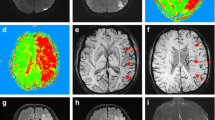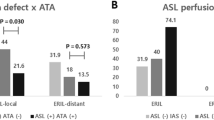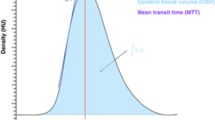Abstract
The purpose of this study was to quantitatively analyze the relationship between three dimensional arterial spin labeling (3D-ASL) and dynamic susceptibility contrast-enhanced perfusion weighted imaging (DSC-PWI) in ischemic stroke patients. Thirty patients with ischemic stroke were included in this study. All subjects underwent routine magnetic resonance imaging scanning, diffusion weighted imaging (DWI), magnetic resonance angiography (MRA), 3D-ASL and DSC-PWI on a 3.0T MR scanner. Regions of interest (ROIs) were drawn on the cerebral blood flow (CBF) maps (derived from ASL) and multi-parametric DSC perfusion maps, and then, the absolute and relative values of ASL-CBF, DSC-derived CBF, and DSC-derived mean transit time (MTT) were calculated. The relationships between ASL and DSC parameters were analyzed using Pearson’s correlation analysis. Receiver operative characteristic (ROC) curves were performed to define the thresholds of relative value of ASL-CBF (rASL) that could best predict DSC-CBF reduction and MTT prolongation. Relative ASL better correlated with CBF and MTT in the anterior circulation with the Pearson correlation coefficients (R) values being 0.611 (P<0.001) and–0.610 (P<0.001) respectively. ROC curves demonstrated that when rASL ≤0.585, the sensitivity, specificity and accuracy for predicting ROIs with rCBF<0.9 were 92.3%, 63.6% and 76.6% respectively. When rASL ≤0.952, the sensitivity, specificity and accuracy for predicting ROIs rMTT>1.0 were 75.7%, 89.2% and 87.8% respectively. ASL-CBF map has better linear correlations with DSC-derived parameters (DSC-CBF and MTT) in anterior circulation in ischemic stroke patients. Additionally, when rASL is lower than 0.585, it could predict DSC-CBF decrease with moderate accuracy. If rASL values range from 0.585 to 0.952, we just speculate the prolonged MTT.
Similar content being viewed by others
References
Petcharunpaisan S, Ramalho J, Castillo M. Arterial spin labeling in neuroimaging. World J Radiol, 2010,2(10): 384–398
Ferre JC, Bannier E, Raoult H, et al. Arterial spin labeling (ASL) perfusion: Techniques and clinical use. Diagn Interv Imaging, 2013,94(12):1211–1223
Petersen ET, Lim T, Golay X. Model-free arterial spin labeling quantification approach for perfusion MRI. Magn Reson Med, 2006,55(2):219–232
Huang YC, Liu HL, Lee JD, et al. Comparison of arterial spin labeling and dynamic susceptibility contrast perfusion MRI in patients with acute stroke. PLoS One, 2013,8(7):e69085
Zaharchuk G, El MI, Fischbein NJ, et al. Comparison of arterial spin labeling and bolus perfusion-weighted imaging for detecting mismatch in acute stroke. Stroke, 2012,43(7):1843–1848
Takasawa M, Jones PS, Guadagno JV, et al. How reliable is perfusion MR in acute stroke? Validation and determination of the penumbra threshold against quantitative PET. Stroke, 2008,39(3):870–877
Wang DJ, Alger JR, Qiao JX, et al. The value of arterial spin-labeled perfusion imaging in acute ischemic stroke: comparison with dynamic susceptibility contrast-enhanced MRI. Stroke, 2012,43(4):1018–1024
Nael K, Meshksar A, Liebeskind DS, et al. Quantitative analysis of hypoperfusion in acute stroke: arterial spin labeling versus dynamic susceptibility contrast. Stroke, 2013,44(11):3090–3096
Niibo T, Ohta H, Yonenaga K, et al. Arterial spin-labeled perfusion imaging to predict mismatch in acute ischemic stroke. Stroke, 2013,44(9):2601–2603
Bivard A, Stanwell P, Levi C, et al. Arterial spin labeling identifies tissue salvage and good clinical recovery after acute ischemic stroke. J Neuroimaging, 2013,23(3):391–396
Chalela JA, Alsop DC, Gonzalez-Atavales JB, et al. Magnetic resonance perfusion imaging in acute ischemic stroke using continuous arterial spin labeling. Stroke, 2000,31(3):680–687
Zaharchuk G. Arterial spin label imaging of acute ischemic stroke and transient ischemic attack. Neuroimaging Clin N Am, 2011,21(2):285–301
Zaharchuk G, Do HM, Marks MP, et al. Arterial spin-labeling MRI can identify the presence and intensity of collateral perfusion in patients with moyamoya disease. Stroke, 2011,42(9):2485–2491
Ishimori Y, Kawamura H, Monma M. Feasibility of MR perfusion-weighted imaging by use of a time-spatial labeling inversion pulse. Radiol Phys Technol, 2013,6(2): 461–466
Zaharchuk G, Bammer R, Straka M, et al. Arterial spin-label imaging in patients with normal bolus perfusion-weighted MR imaging findings: pilot identification of the borderzone sign. Radiology, 2009,252(3):797–807
Wang R, Yu S, Alger JR, et al. Multi-delay arterial spin labeling perfusion MRI in moyamoya disease—comparison with CT perfusion imaging. Eur Radiol, 2014,24(5): 1135–1144
Qiu D, Straka M, Zun Z, et al. CBF measurements using multidelay pseudocontinuous and velocity-selective arterial spin labeling in patients with long arterial transit delays: comparison with xenon CT CBF. J Magn Reson Imaging, 2012,36(1):110–119
Fan L, Tao XF, Liu SY, et al. Preliminary study of clinical application of arterial spin labeling in the diagnosis of central nervous system diseases. Radiol Pract (Chinese), 2007,22(7):675–678
Rohl L, Ostergaard L, Simonsen CZ, et al. Viability thresholds of ischemic penumbra of hyperacute stroke defined by perfusion-weighted MRI and apparent diffusion coefficient. Stroke, 2001,32(5):1140–1146
Zaharchuk G, Mandeville JB, Bogdanov AJ, et al. Cerebrovascular dynamics of autoregulation and hypoperfusion. AnMRI study of CBF and changes in total and microvascular cerebral blood volume during hemorrhagic hypotension. Stroke, 1999,30(10):2197–2204
Koenig M, Kraus M, Theek C, et al. Quantitative assessment of the ischemic brain by means of perfusion-related parameters derived from perfusion CT. Stroke, 2001,32(2):431–437
Author information
Authors and Affiliations
Corresponding author
Additional information
This project was supported by grants from the 12th Five-year Science and Technology Support Program of China (No. 2011BAI08B10) and the National Natural Science Foundation of China (No. 81171308, No. 81570462)
Rights and permissions
About this article
Cite this article
Zhang, Sx., Yao, Yh., Zhang, S. et al. Comparative study of DSC-PWI and 3D-ASL in ischemic stroke patients. J. Huazhong Univ. Sci. Technol. [Med. Sci.] 35, 923–927 (2015). https://doi.org/10.1007/s11596-015-1529-8
Received:
Revised:
Published:
Issue Date:
DOI: https://doi.org/10.1007/s11596-015-1529-8




